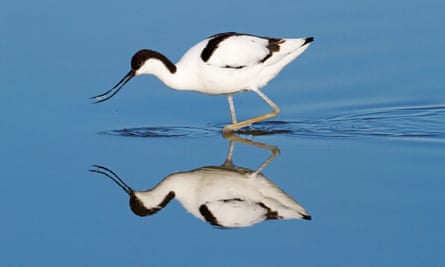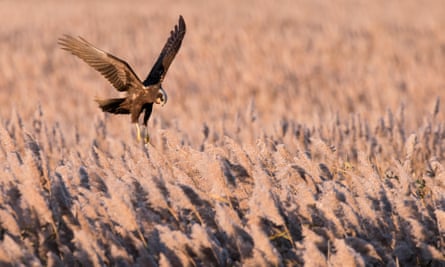Minsmere and I go back a long way. I can still remember the thrill of my first visit, in 1973, when I was just 13 years old. Later, I made my very first wildlife programme there, with Bill Oddie. And most recently, I presented live programmes from the reserve on the BBC’s red button for Springwatch.
So naturally I am worried that this unique place could be ruined by the proposed building of Sizewell C nuclear power station, a few hundred metres down the coast. And I’m not the only one. My colleague Chris Packham, who like me first went there as a teenager, has called on EDF Energy to ensure that it safeguards Minsmere and its wildlife, now and in the future.
More than 20,000 people have already written to EDF to raise their concerns, and the RSPB – which is firmly against the plans – is holding a Love Minsmere festival at the reserve on 15 September.
There are more than 200 RSPB reserves in the UK – so what makes Minsmere special? The main reason is the incredible range of species found in such a small area – just 1,000 hectares (2,500 acres).
The reserve’s bird list currently stands at nearly 350 species, of which more than 100 have bred; while more than 1,000 types of butterfly and moth have been recorded, including the eponymous Minsmere crimson underwing, recorded just once in the UK, here at Minsmere.
This is all thanks to a complex mosaic of habitats, including woodland, scrub, meadow, heath, freshwater wetland and coastal marsh.

Yet the name Minsmere might have remained obscure were it not for a quirk of military history. During the second world war, there were very real fears of a Nazi invasion across the North Sea. To create a barrier against a seaborne attack, farmland along the Suffolk coast was deliberately flooded and this accidentally created an ideal home for wetland birds.
Two years after the end of the conflict, in 1947, avocets returned to breed in the UK after an absence of more than a century. They did so at Minsmere, and this led the RSPB to lease (and eventually buy) the land from local owners and turn it into a nature reserve.
As a teenager, I remember hearing about this famous place, with its impossibly exotic birds, including avocets, bitterns and marsh harriers. I nagged my mother to take me there until finally she gave in. So, in April 1973, we drove up the A12 from our suburban London home to Suffolk, intending to spend as much time as possible at Minsmere. That was not as easy as it sounds: in those days, the reserve was open only four days a week, and you had to apply in advance, by post, for one of a limited number of permits.
On the day of our first visit, I could hardly contain my excitement. I can still remember seeing my very first avocet: that striking piebald plumage, distinctive upturned bill, and best of all, the bright blue legs. But I was even more thrilled when I saw the celebrated warden of Minsmere – Bert Axell – walking along with a group of people. We followed them discreetly into a hide, where we scanned the horizon for marsh harriers.
At the time, Minsmere was home to the only breeding trio of this polygynous (one male mating with several females) raptor in Britain, but sightings were few and far between. My mother didn’t have a great interest in birdwatching and never used binoculars, so when a large brown bird flew up to the hide, unseen by the rest of us, she casually drew our attention to its presence.
“My goodness, a marsh harrier,” boomed Bert. “Well done, madam!”
Axell was not the first warden of Minsmere, but he was largely responsible for turning it into what it is today. He was both a visionary and a zealot, who kept up a running battle with his superiors at RSPB HQ in Sandy, Bedfordshire. In his view, they were deskbound bureaucrats, intent on stifling his ideas for improving the reserve for birds.
True to character, Axell simply ignored them, and pressed ahead with what at the time seemed a harebrained plan. He decided to create an artificial wetland, known as the Scrape, with individually numbered islands on which avocets and other waterbirds could nest, and shallow areas of brackish water where they could feed.

Not only did the Scrape become one of the best-known birding hotspots in the UK, but Axell later took his idea all around the world, creating wetland reserves on the same model.
More than 20 years after my first visit, Oddie and I met to discuss the location for the opening episode of our TV series Birding with Bill Oddie. He suggested the idea of spending a single day, in early May, exploring one very special place for birds. I asked him where he would suggest and, in perfect unison, we both uttered a single word: “Minsmere!”
We began filming before sunrise, listening to a spectacular dawn chorus in the woods. Afterwards, while we were enjoying breakfast in the recently built visitor centre and cafe, Oddie suddenly dropped his knife and fork, grabbed his binoculars, and ran outside. The camera crew and I emerged moments later, to find him happily watching sand martins, just back from Africa, swooping in and out of their nest-holes in a sandbank.
After that excellent beginning, we enjoyed an action-packed day. Oddie showed us how to tell reed and sedge warblers apart by their song; we came across three baby tawny owls, looking like huge balls of fluff as they sat on a branch in broad daylight; and, as dusk fell, we enjoyed the special sight of cranes flying in to roost. It all made for a delightful programme, which helped launch our careers in wildlife television.
That was almost a quarter of a century ago. Since then, Minsmere and its birds have changed – and not always for the better. It was once possible to see or hear 100 different species before breakfast, but with the loss of birds such as the lesser spotted woodpecker, tree sparrow and corn bunting, that sadly no longer happens.
On the credit side, new species have colonised the reserve, including the Cetti’s warbler and Mediterranean gull. And rarities such as Britain’s first western swamphen (which looks like a giant purple moorhen), and an all-too-brief visit in 2015 from a black-browed albatross, have attracted hordes of twitchers.
The sheer variety of birds in such a small area made Minsmere the ideal destination for Springwatch, which was based on the reserve for three years, from 2014 to 2016. In what would be my final job in wildlife television, I spent a fortnight broadcasting live on the red button. The assignment brought back many happy memories of Minsmere and its birds.

Among many memorable moments, highlights included Arctic waders dropping in on the Scrape on their long journey south to Africa; a determined stoat climbing several metres up a tree to slaughter a brood of green woodpeckers; and, best of all, a sparrowhawk chick hatching out of its egg, right in front of our eyes. I was constantly reminded of the capacity of nature to astonish and entertain.
Being back at Minsmere, so long after my first visit, reminded me that this is a crucial haven for wildlife in a rapidly changing world. It also confirmed my belief that places like this – where people can engage with wildlife, guided by the RSPB’s superb staff and volunteers – offer an essential service to people, at a time when we all need nature more than ever.
So I hope and pray that, whatever happens with the nuclear power station next door, this unique place will continue to thrive. And most of all, I hope that teenage boys and girls who come to Minsmere for the very first time will be enthralled by its birds – just as I was, all those many years ago.
Stephen Moss is a naturalist, author and lecturer
